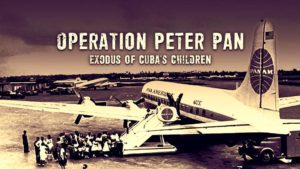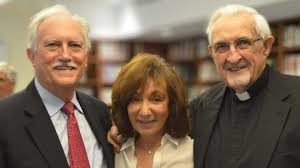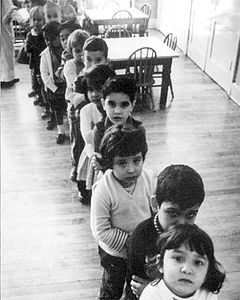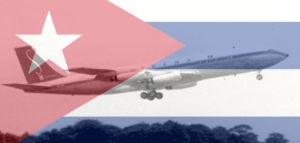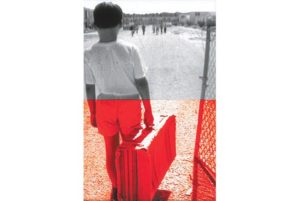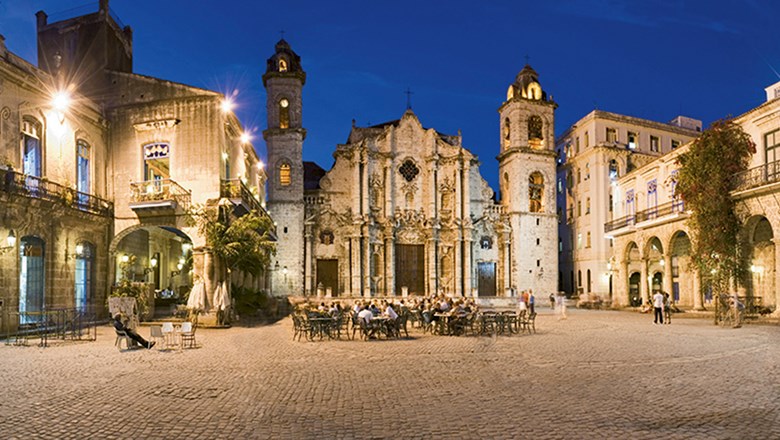OPERATION PETER PAN: MASS EXODUS OF 14,000 UNACCOMPANIED CUBAN MINORS TO THE UNITED STATES (1960-1962). PHOTOS.
Operation Peter Pan (or Operación Pedro Pan) was a clandestine mass exodus of over 14,000 unaccompanied Cuban minors ages 6 to 18 to the United States over a two-year span from 1960 to 1962. They were sent by alarmed parents who heard rumors that Fidel Castro and the Communist party were planning to terminate parental rights and place minors in communist indoctrination centers.
The program consisted of two main components: the mass evacuation of Cuban children via airplane to the US – Miami as a particularly common hub – and the programs set up to care for them once they arrived. Both were led by Father Bryan O. Walsh of the Catholic Welfare Bureau. The operation was the largest mass exodus of minor refugees in the Western Hemisphere at the time. It operated covertly out of fear that it would be viewed as an anti-Castro political enterprise.
ORIGINS OF THE OPERATION PETER PAN
By 1960 the Cuban government began reforming education strategies. School children were taught military drills, how to bear arms, and anti-American songs. By 1961 the Cuban government would seize control of all private schools.
As a result of the new social order, rumors began to swirl, originating from both inside the United States and other anti-Castro media. Various outlets, including Miami’s own Miami Herald and Time Magazine, reported that Castro and his followers intended to terminate parental rights, assume custody of all Cuban children, prohibit religion and indoctrinate them into communism.
These rumors, combined with the pre-existing worry instilled by the Spanish Civil War (during which children were evacuated to the Soviet Union), made the Patria potestad hoax impossible to contain. It had already reached the Catholic church and the general public, and opponents of the revolution who could not afford to flee during the first wave of the exodus began shipping their children off to safety.
START THE OPERATION PETER PAN
Having been involved in a similar program that gained young Hungarians entrance to the US following Soviet repression of the 1956 uprising, Father Bryan O. Walsh of the Catholic Welfare Bureau, with the help of the U.S. government, developed the Cuban Children’s Program in late 1960. Key players included Tracy Voorhees, Eisenhower Administration, James Baker, and, of course, Father Walsh.
By most accounts, the story is as follows: An October meeting brought the influx of Cuban refugees in Miami to the attention of the White House, with particular focus on what appeared to be a high number of unaccompanied minors wandering the city. Shortly after, Tracy Voorhees – a veteran U.S. government official who was serving as the president’s Personal Representative for Cuban Refugees – reported that, though the issue was not large in number, it had still been highly publicized and, therefore, the administration needed to be seen taking action.
Up until that time, the Catholic church had been the largest provider of aid. But, towards the end of 1960, President Eisenhower approved $1 million dollars to help, with specific funds allocated to the creation of a Cuban emergency refugee center. To further their efforts, and ultimately further the smear campaign of Castro’s Cuba, Vorhees recommended the administration further their involvement, this time taking a specific interest in caring for the Cuban refugee children.
Simultaneously, James Baker (headmaster of an American school in Havana) met with Walsh (who was already invested in helping already arrived child refugees settle into their new life) to detail his efforts in helping parents send their children to Miami. Baker’s original goal was to establish a boarding school in the United States for Cuban refugee children. However, both later agreed professional social welfare agencies would be better equipped for the job. The Catholic Welfare Bureau, the Children’s Services Bureau, and Jewish Family and Children’s Services were the agencies that ultimately agreed to care for the refugee children. Thus, in November 1960, they appealed for federal funding, and, following the earlier recommendation from Vorhees, it was granted.
Baker would arrange the children’s transportation and facilitate visas, Walsh would arrange for accommodations in Miami and Operation Pedro Pan was a done deal. Underground organizations led by the involved parents helped spread information. Among those who helped alert parents about the program were Penny Powers, Pancho, and Bertha Finlay, Drs. Sergio and Serafina Giquel, Sara del Toro de Odio and Albertina O’Farril. To maintain confidentiality, the program’s leaders in the U.S. minimized communications with their contacts in Cuba.
OPERATION PETER PAN ENDS
By January 1961, 6,500 Cuban children were enrolled in Miami and Miami-adjacent schools. By September 1962, that number had jumped to 19,000. And while Pedro Pans are often depicted as babies, infants, or elementary-school-aged children, most of them were actually teenaged boys. A lack of limitations placed on how many were admitted coupled with federally-funded foster care made the Cuban Children’s Program one like any other. It only continued to grow and get more complex.
In January 1961, the U.S. embassy of Cuba closed, but Operation Peter Pan persisted. Instead of visas, children received waivers in the form of simple letters signed by Walsh effectively gaining them entrance into the country. Airlines were instructed to accept these letters as official documents and, as an added incentive, the U.S. government covered the cost of flights.
From there, things continued to spiral. In September of that year, the State Department began allowing Cuban child refugees to apply for visa waivers on behalf of their parents. For many who could not otherwise afford it or did not already have other relatives in the United States, this became a fairly regular means of familial immigration. Only one month later, the Cuban Missile Crisis ceased all air travel between the U.S. and Cuba.
Operation Peter Pan ended when all air traffic between the United States and Cuba ceased in the aftermath of the Cuban Missile Crisis of October 1962. Cuban immigrants needed to travel via Spain or Mexico to reach the United States until December 1965, when the United States established a program of Freedom Flights to unite Cuban parents with their children. The Catholic Welfare Bureau reported that, once the Freedom Flights began, nearly 90% of the minors still in its care were reunited with their parents.
PARTICIPANTS IN OPERATION PETER PAN
Unaccompanied Cuban minors, known at the time as “Pedro Pans” or “Peter Pans”, who were part of the operation include:
Eduardo Aguirre, United States Ambassador to Spain (2005–2009)
Frank Angones, first Cuban-born head of the Florida Bar
Fred Beato, Cuban-American musician, and business owner.
Carlos Mayans, former mayor of Wichita, Kansas
Willy Chirino, Cuban-American musician, and salsa singer
Carlos Eire, author, professor of the history of religion at Yale University
Felipe de Jesus Estevez, bishop Roman Catholic diocese of St. Augustine (2011–)
Mario Garcia, newspaper designer, and media consultant
Hugo Llorens, United States Ambassador to Honduras (2008 – 2011) and United States Ambassador to Afghanistan (2016–17)
Ana Mendieta, artist
Guillermo “Bill” Vidal, former Mayor of Denver (2011) and author of Boxing for Cuba
Miguel Bezos, Jeff Bezos’ (Amazon.com’s founder) stepfather, who raised him since he was 4 years old
U.S. Senator Mel Martinez, former Florida Senator and first Latino chairman of the Republican party
Lissette Alvarez, singer-songwriter
Eduardo J. Padrón, former President of Miami Dade College (1995-2019)
Demetrio Perez Jr., educator, politician, radio commentator, entrepreneur, and publisher of LIBRE, a bilingual weekly newspaper, and founded the Lincoln-Marti educational group.
Dave Lombardo, drummer of the heavy metal band Slayer.
OPERACIÓN PETER PAN: EXODO MASIVO DE 14,000 MENORES CUBANOS SIN ACOMPAÑANTES A LOS ESTADOS UNIDOS (1960-1962). PHOTOS.
La Operación Peter Pan fue un éxodo masivo clandestino de más de 14.000 menores cubanos no acompañados de 6 a 18 años a los Estados Unidos durante un período de dos años desde 1960 a 1962. Fueron enviados por padres alarmados que escucharon rumores de que Fidel Castro y el Partido Comunista planeaban poner fin a la patria potestad y colocar a los menores en centros de adoctrinamiento comunista.
El programa constaba de dos componentes principales: la evacuación masiva de niños cubanos por avión a los Estados Unidos – Miami como un centro particularmente común – y los programas establecidos para cuidarlos una vez que llegaban. Ambos fueron dirigidos por el padre Bryan O. Walsh del Catholic Welfare Bureau. La operación fue el mayor éxodo masivo de refugiados menores en el hemisferio occidental en ese momento. Operó de forma encubierta por temor a ser visto como una empresa política anticastrista.
ORÍGENES DE LA OPERACIÓN PETER PAN
En 1960, el gobierno cubano comenzó a reformar las estrategias educativas. A los escolares se les enseñó ejercicios militares, cómo portar armas y canciones antiamericanas. En 1961, el gobierno cubano tomaría el control de todas las escuelas privadas.
Como resultado del nuevo orden social, los rumores comenzaron a arremolinarse, provenientes tanto del interior de Estados Unidos como de otros medios anticastristas. Varios medios, incluidos el Miami Herald y la revista Time de Miami, informaron que Castro y sus seguidores tenían la intención de terminar con los derechos de los padres, asumir la custodia de todos los niños cubanos, prohibir la religión y adoctrinarlos en el comunismo.
Estos rumores, combinados con la preocupación preexistente inculcada por la Guerra Civil española (durante la cual los niños fueron evacuados a la Unión Soviética), hicieron imposible contener el engaño de Patria potestad. Ya había llegado a la iglesia católica y al público en general, y los oponentes de la revolución que no podían permitirse huir durante la primera ola del éxodo comenzaron a enviar a sus hijos a un lugar seguro.
INICIOS DE LA OPERACIÓN PETER PAN
Habiendo estado involucrado en un programa similar que hizo que los jóvenes húngaros ingresaran a los Estados Unidos luego de la represión soviética del levantamiento de 1956, el padre Bryan O. Walsh del Catholic Welfare Bureau, con la ayuda del gobierno de los Estados Unidos, desarrolló el Programa para Niños Cubanos a fines de 1960. Los jugadores clave incluyeron a Tracy Voorhees, la administración de Eisenhower, James Baker y, por supuesto, el padre Walsh.
Según la mayoría de los relatos, la historia es la siguiente: una reunión de octubre llamó la atención de la Casa Blanca sobre la afluencia de refugiados cubanos en Miami, con especial atención a lo que parecía ser un gran número de menores no acompañados que deambulaban por la ciudad. Poco después, Tracy Voorhees, una funcionaria veterana del gobierno de los EE. UU. Que se desempeñaba como Representante Personal del presidente para los refugiados cubanos, informó que, aunque el tema no era muy numeroso, todavía había recibido una gran publicidad y, por lo tanto, la administración necesitaba ser revisada. visto tomando acción.
Hasta ese momento, la Iglesia Católica había sido el mayor proveedor de ayuda. Pero, hacia fines de 1960, el presidente Eisenhower aprobó $ 1 millón de dólares para ayudar, con fondos específicos destinados a la creación de un centro cubano de emergencia para refugiados. Para promover sus esfuerzos y, en última instancia, promover la campaña de difamación de la Cuba de Castro, Vorhees recomendó que la administración aumentara su participación, esta vez con un interés específico en el cuidado de los niños refugiados cubanos.
Simultáneamente, James Baker (director de una escuela estadounidense en La Habana) se reunió con Walsh (quien ya estaba comprometido en ayudar a los niños refugiados que ya habían llegado a establecerse en su nueva vida) para detallar sus esfuerzos para ayudar a los padres a enviar a sus hijos a Miami. El objetivo original de Baker era establecer un internado en los Estados Unidos para los niños refugiados cubanos. Sin embargo, ambas agencias profesionales de bienestar social acordaron más tarde estarían mejor equipadas para el trabajo. La Oficina de Bienestar Católico, la Oficina de Servicios para Niños y los Servicios para Niños y Familias Judías fueron las agencias que finalmente acordaron cuidar a los niños refugiados. Así, en noviembre de 1960, solicitaron fondos federales y, siguiendo la recomendación anterior de Vorhees, se les concedió.
Baker organizaría el transporte de los niños y facilitaría las visas, Walsh organizaría el alojamiento en Miami y la Operación Pedro Pan fue un trato hecho. Las organizaciones clandestinas dirigidas por los padres involucrados ayudaron a difundir información. Entre los que ayudaron a alertar a los padres sobre el programa se encontraban Penny Powers, Pancho y Bertha Finlay, los Dres. Sergio y Serafina Giquel, Sara del Toro de Odio y Albertina O’Farril. Para mantener la confidencialidad, los líderes del programa en Estados Unidos minimizaron las comunicaciones con sus contactos en Cuba.
OPERACIÓN PETER PAN TERMINA
Para enero de 1961, 6.500 niños cubanos estaban matriculados en Miami y escuelas adyacentes a Miami. En septiembre de 1962, ese número había aumentado a 19.000. Y aunque los Pedro Pans a menudo se representan como bebés, infantes o niños en edad de escuela primaria, la mayoría de ellos eran en realidad adolescentes. La falta de limitaciones sobre la cantidad de personas admitidas, junto con el cuidado de crianza con fondos federales, hizo que el Programa de Niños Cubanos fuera como cualquier otro. Solo siguió creciendo y volviéndose más complejo.
En enero de 1961, la embajada estadounidense de Cuba cerró, pero la Operación Peter Pan persistió. En lugar de visas, los niños recibieron exenciones en forma de cartas simples firmadas por Walsh que les permitieron ingresar al país. Las aerolíneas recibieron instrucciones de aceptar estas cartas como documentos oficiales y, como incentivo adicional, el gobierno de los Estados Unidos cubrió el costo de los vuelos.
A partir de ahí, las cosas continuaron en espiral. En septiembre de ese año, el Departamento de Estado comenzó a permitir que los niños refugiados cubanos solicitaran exenciones de visa en nombre de sus padres. Para muchos que de otra manera no podrían pagarlo o que no tenían ya otros parientes en los Estados Unidos, esto se convirtió en un medio bastante regular de inmigración familiar. Solo un mes después, la Crisis de los Misiles de Cuba cesó todos los viajes aéreos entre Estados Unidos y Cuba.
La Operación Peter Pan terminó cuando cesó todo el tráfico aéreo entre Estados Unidos y Cuba tras la crisis de los misiles cubanos de octubre de 1962. Los inmigrantes cubanos debían viajar a través de España o México para llegar a Estados Unidos hasta diciembre de 1965, cuando Estados Unidos estableció un programa de Freedom Flights para unir a los padres cubanos con sus hijos. La Oficina de Bienestar Católica informó que, una vez que comenzaron los Vuelos de la Libertad, casi el 90% de los menores que aún estaban bajo su cuidado se reunieron con sus padres.
PARTICIPANTES EN LA OPERACIÓN PETER PAN
Entre los menores cubanos no acompañados, conocidos en ese momento como “Pedro Pans” o “Peter Pans”, que formaron parte del operativo podemos citar algunos que mas tarde se distingieron como:
– Eduardo Aguirre, Embajador de los Estados Unidos en España (2005-2009)
– Frank Angones, primer director del Colegio de Abogados de Florida nacido en Cuba
– Fred Beato, músico cubanoamericano y empresario.
– Carlos Mayans, ex alcalde de Wichita, Kansas
– Willy Chirino, músico cubanoamericano y cantante de salsa
– Carlos Eire, autor, profesor de historia de la religión en la Universidad de Yale
– Felipe de Jesus Estévez, obispo de la diócesis católica romana de San Agustín (2011–)
– Mario García, diseñador de periódicos y consultor de medios
– Hugo Llorens, embajador de Estados Unidos en Honduras (2008-2011) y embajador de Estados Unidos en Afganistán (2016-17)
– Ana Mendieta, artista
– Guillermo “Bill” Vidal, ex alcalde de Denver (2011) y autor de Boxing for Cuba
– Miguel Bezos, padrastro de Jeff Bezos (fundador de Amazon.com), quien lo crió desde los 4 años
– El senador estadounidense Mel Martinez, exsenador de Florida y primer presidente latino del partido republicano
– Lissette Alvarez, cantautora
– Eduardo J. Padrón, ex presidente de Miami Dade College (1995-2019)
– Demetrio Pérez Jr., educador, político, comentarista de radio, empresario y editor de LIBRE, un semanario bilingüe, y fundó el grupo educativo Lincoln-Marti.
– Dave Lombardo, baterista de la banda de heavy metal Slayer.
Agencies/ Wiki/ Excerpts/ Extractos/ Internet Photos/ Arnoldo Varona/ www.TheCubanHistory.com
THE CUBAN HISTORY, HOLLYWOOD.




